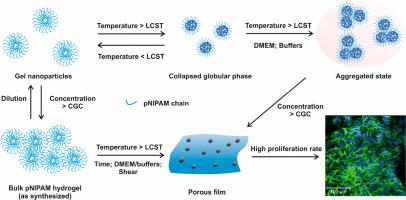Biomaterials Advances ( IF 7.9 ) Pub Date : 2020-09-11 , DOI: 10.1016/j.msec.2020.111507 Jagoda Litowczenko , Jacek Gapiński , Roksana Markiewicz , Anna Woźniak , Jacek K. Wychowaniec , Barbara Peplińska , Stefan Jurga , Adam Patkowski

|
In this work, we show synthesis that leads to thermoreponsive poly-N-isopropyl acrylamide (pNIPAM) nanogels with sizes below 100 nm, irrespectively of the surfactant to crosslinker ratio. We also show that in many environments the temperature induced pNIPAM collapse at Lower Critical Solution Temperature (LCST) of 32.5°C is accompanied by gel nanoparticles’ aggregation. Thus, the proper information on the nanoparticle (NP) structure and deswelling can be obtained only if the routinely measured hydrodynamic radius is supplemented by information on the molecular weight, which can be obtained from the intensity of scattered light. We measured the dynamics and reversibility of the deswelling and subsequent aggregation processes.
Furthermore, we show that the highly concentrated pNIPAM gel NPs reversibly form bulk hydrogel networks of varied interconnected porous structure. We show, that in case of drying pNIPAM gel NPs above the LCST, it is possible to obtain films with 20-fold increase in storage modulus (G′) compared to hydrogel networks measured at room temperature. They exhibit temperature hysteresis behavior around LCST of 32.5°C similar to pNIPAM films. Finally, we show that these hydrogel films, lead to extended proliferation of cells across three different types: fibroblast, endothelial and cancer cells. Additionally, none of the films exhibited any cytotoxic effects. Our study brings new insights into physicochemical characterization of pNIPAM gel NPs and networks behavior in realistic conditions of in vitro measurements, especially by means of dynamic light scattering as well as final unique properties of both gel NPs and formed porous films for possible tissue engineering applications.
中文翻译:

聚-N-异丙基丙烯酰胺凝胶纳米颗粒和薄膜的合成,表征和体外细胞毒性研究
在这项工作中,我们显示了无论表面活性剂与交联剂的比率如何,均可导致尺寸小于100 nm的热响应性聚N-异丙基丙烯酰胺(pNIPAM)纳米凝胶的合成。我们还表明,在许多环境中,温度诱导的pNIPAM在32.5°C的较低临界溶液温度(LCST)下崩溃,伴随着凝胶纳米颗粒的聚集。因此,仅当常规测量的流体力学半径补充有分子量的信息时,才能获得有关纳米粒子(NP)结构和溶胀的适当信息,该信息可以从散射光的强度中获得。我们测量了溶胀和后续聚集过程的动力学和可逆性。
此外,我们表明,高度浓缩的pNIPAM凝胶NP可逆地形成各种相互连接的多孔结构的本体水凝胶网络。我们表明,在将pNIPAM凝胶NP干燥至LCST以上的情况下,与在室温下测量的水凝胶网络相比,可以获得储能模量(G')增加20倍的薄膜。它们在LCST约为32.5°C时表现出温度滞后行为,类似于pNIPAM膜。最后,我们证明了这些水凝胶膜可导致细胞跨三种不同类型的扩展增殖:成纤维细胞,内皮细胞和癌细胞。另外,这些膜都没有表现出任何细胞毒性作用。我们的研究为pNIPAM凝胶NP的理化表征和网络在体外实际条件下的行为带来了新见解 尤其是通过动态光散射以及凝胶NP和形成的多孔膜的最终独特性能进行测量,以用于可能的组织工程应用。


























 京公网安备 11010802027423号
京公网安备 11010802027423号